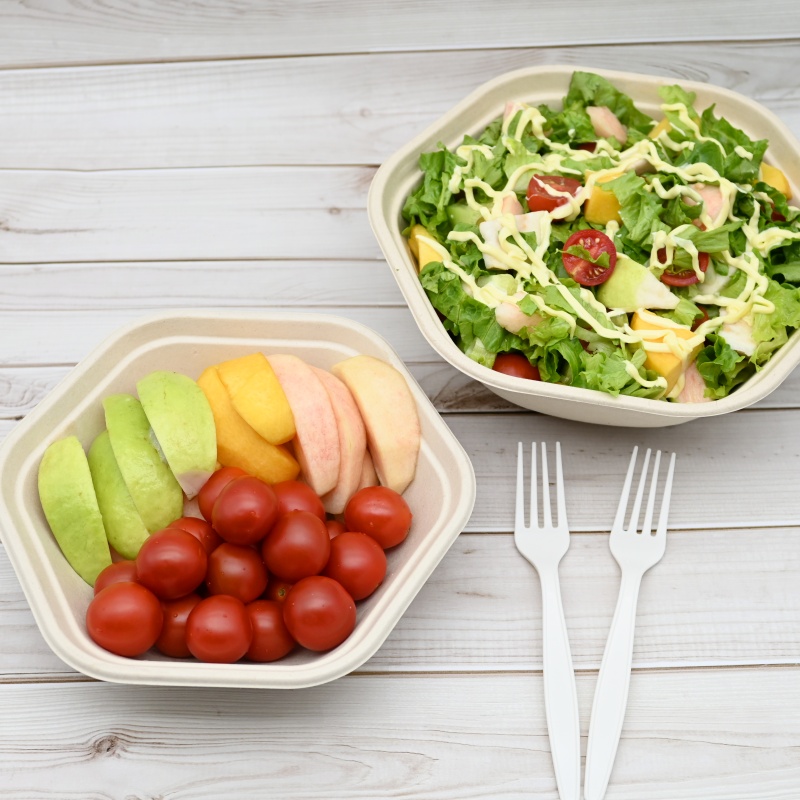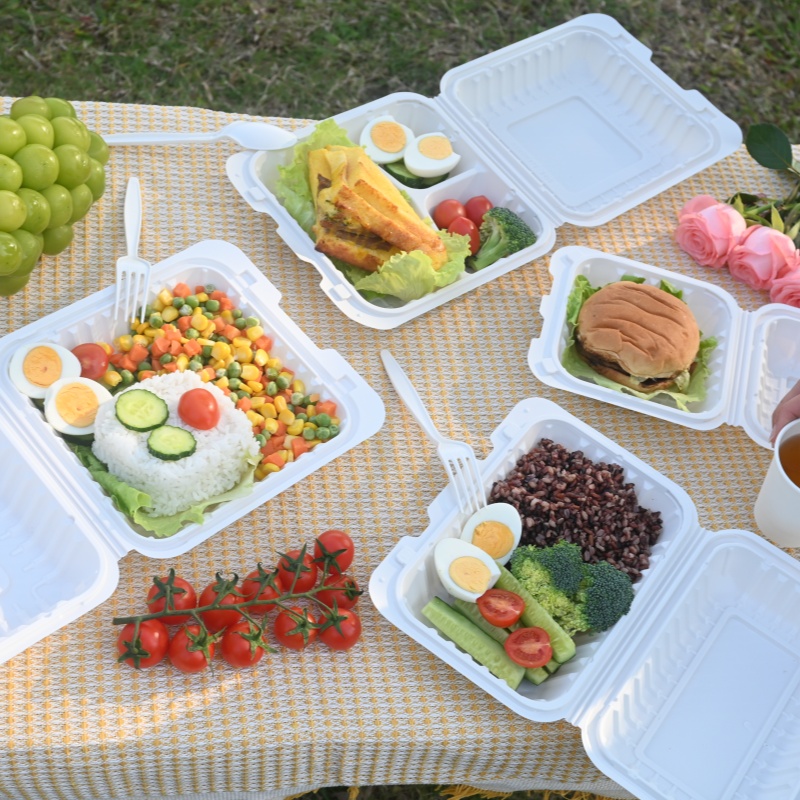Drivers of Innovation in Food Container Packaging
In recent years, innovation in food container packaging has primarily been driven by the push for sustainability. With growing global environmental awareness, consumer demand for eco-friendly products is increasing. Biodegradable, compostable food containers and packaging have become market favorites, and companies are continuously developing and promoting these sustainable materials and technologies. For example, sugarcane and cornstarch food containers are significant components of the eco-friendly food container market due to their renewable and biodegradable properties. Additionally, government policies and regulations have profoundly impacted the packaging industry. Many countries and regions have implemented plastic bans, requiring the reduction of plastic packaging use and the promotion of recyclable and renewable materials.
Simultaneously, technological advancements provide technical support for packaging innovation. New materials and manufacturing processes make food container packaging more environmentally friendly while better meeting consumer needs. By applying smart packaging technologies, companies can achieve more efficient logistics management and provide better consumer experiences. In summary, environmental policies, market demand, and technological advancements are the three main drivers of innovation in food container packaging.

How Are Packaging and Design Developing to Engage Consumers?
Innovation in food container packaging and design is not limited to the environmental sustainability of materials but also includes improvements in functionality and aesthetics. Modern consumers expect packaging not only to protect food but also to convey the brand's values and personality. Therefore, designers must consider sustainability and the uniqueness and user experience in their designs.
In terms of functionality, food container packaging needs to have basic features such as being leak-proof, moisture-resistant, and insulated. Additionally, to meet the needs of different scenarios, food container packaging must be portable and easy to open. For example, sugarcane and corn starch food containers are designed to be environmentally friendly and user-friendly. In terms of aesthetics, designers use clever combinations of colors, patterns, and shapes to make the packaging more attractive, enhancing brand recognition and consumer purchase desire.
Furthermore, the development of smart packaging technology offers more interactive experiences for consumers. For instance, by embedding QR codes on the packaging, consumers can scan them to get detailed product information, track logistics status, and even participate in brand activities. These innovative designs not only increase consumer engagement but also enhance the interaction between brands and consumers.
What Are the Main Current Trends in Packaging and Design?
The main current trends in food container packaging and design focus on sustainability, intelligence, and personalization. Firstly, sustainability is one of the core trends in the packaging industry. With increasing environmental awareness, biodegradable, compostable food containers and packaging have become mainstream products. Sugarcane and corn starch food containers are favored by consumers due to their eco-friendly and health benefits. Companies pay more attention to using renewable materials in research and production processes, optimizing processes to reduce carbon emissions and resource consumption.
Secondly, smart packaging is gradually emerging. Smart packaging can improve logistics efficiency and enhance consumer experiences. For example, by embedding sensors in the packaging, it can monitor the temperature and humidity of the food to ensure its freshness. Additionally, smart packaging can achieve transparency and traceability of product information through technologies such as QR codes, enhancing consumer trust.
Finally, personalized design is also a major trend in food container packaging. Consumers increasingly value the uniqueness and personalized experience of products. Companies offer customized services, providing packaging designs that meet consumer needs and preferences. For example, customized takeaway coffee cups and printed coffee cups meet consumers' personalized needs and enhance brand uniqueness and market competitiveness.

How Have These Trends Changed Over the Years? Which Trends Will Remain Unchanged?
Over the past few years, the trend towards sustainability in food container packaging has become more evident. With the introduction of environmental regulations and increased consumer environmental awareness, companies have significantly increased their investments in eco-friendly materials and processes. Biodegradable and compostable food containers have gradually transitioned from niche markets to mainstream, becoming products that major brands are eager to launch. Particularly, sugarcane and corn starch food containers are increasingly favored by consumers due to their eco-friendly properties and compostability.
The application of smart packaging has also expanded continuously. In the past, smart packaging was mainly used for high-end products and cold chain logistics. Now, with the reduction and popularization of technological costs, more daily consumer goods are beginning to adopt smart packaging technology. Consumers can easily obtain product information through smart packaging, enhancing the shopping experience.
The trend of personalized design has always remained stable and continuously developed. With the increasing demand for personalization and customization from consumers, companies are constantly innovating in design. Customized packaging not only enhances brand recognition but also improves consumer satisfaction and loyalty. Therefore, personalized design will continue to be an important trend in food container packaging.
In summary, although packaging materials and technologies are constantly evolving, the three major trends of sustainability, intelligence, and personalization will remain unchanged and continue to lead the development direction of the food container packaging industry.
What Challenges Has MVI ECOPACK Encountered in Sustainable Packaging and Labeling? What Measures Have Been Taken to Overcome These Challenges?
Despite the many advantages of sustainable packaging and labeling, there are still many challenges in practical applications. Firstly, there is the issue of cost. The research and production costs of eco-friendly materials and technologies are high, leading to higher product prices and difficulty in widespread market adoption. Secondly, there are performance issues. The physical properties of eco-friendly materials still lag behind traditional materials in some aspects, such as heat resistance and oil resistance, which need improvement. Additionally, consumer awareness and acceptance of eco-friendly materials need to be enhanced.
To overcome these challenges, MVI ECOPACK has taken several measures. Firstly, the company has increased its investment in the research and development of eco-friendly materials and technologies, continuously innovating and optimizing processes to improve product performance and cost-effectiveness. The development and promotion of sugarcane and corn starch food containers have become highlights in the company's eco-friendly food container market. Secondly, the company has strengthened cooperation with various parts of the supply chain, reducing costs through large-scale production and centralized procurement. Furthermore, the company promotes the advantages of eco-friendly packaging through multiple channels, enhancing consumer awareness and acceptance.
At the same time, MVI ECOPACK actively participates in various environmental certifications and standards to ensure that products meet international environmental standards, enhancing consumer trust. Through these efforts, MVI ECOPACK has not only improved its product competitiveness but also contributed to the sustainable development of the packaging industry.

What Role Does Sustainability Play in Packaging Innovation and Consumer Purchasing Decisions?
Sustainability plays an increasingly important role in packaging innovation and consumer purchasing decisions. For companies, sustainability is not only a social responsibility but also a market competitiveness. By adopting biodegradable and compostable food containers and other eco-friendly products, companies can reduce their environmental impact, enhance their brand image, and gain consumer recognition and trust.
For consumers, sustainability has become an important factor influencing their purchasing decisions. With increasing environmental awareness, consumers are more inclined to choose eco-friendly packaging products. Many consumers are willing to pay higher prices for eco-friendly products to express their support for environmental protection. Therefore, incorporating sustainability elements in packaging innovation not only meets consumer needs but also enhances market competitiveness.
In summary, sustainability plays a crucial role in packaging innovation and consumer purchasing decisions. By continuously promoting the research and application of sustainable packaging, companies can achieve sustainable development and contribute to global environmental protection.
In conclusion, the major trends in food container packaging innovation focus on sustainability, intelligence, and personalization. By continuously optimizing materials and processes, enhancing design and functionality, companies can meet consumer needs and promote sustainable industry development. In the future, eco-friendliness, intelligence, and personalization will continue to lead the innovation direction of food container packaging, providing consumers with a better user experience.
Post time: Aug-07-2024










